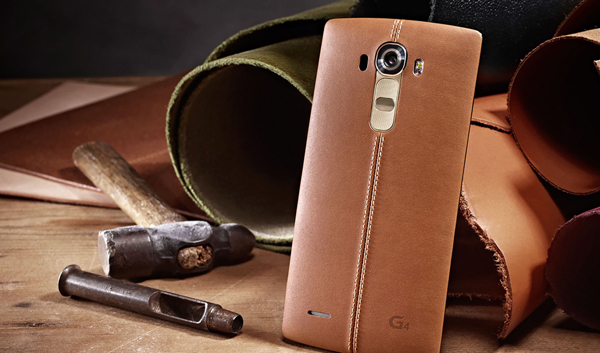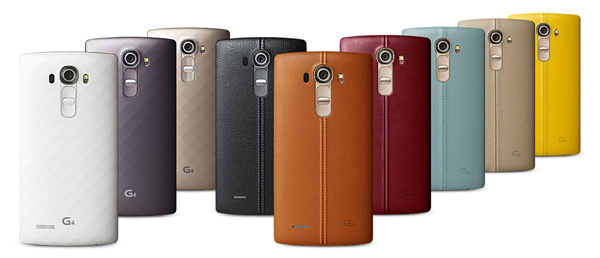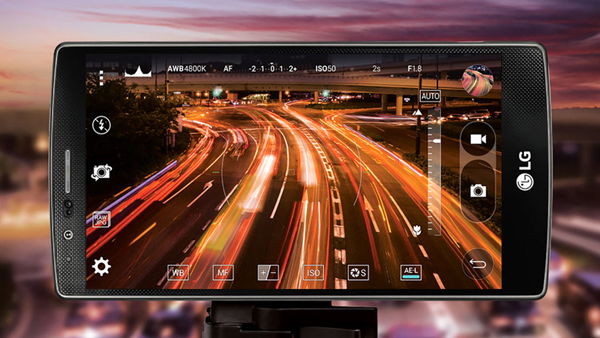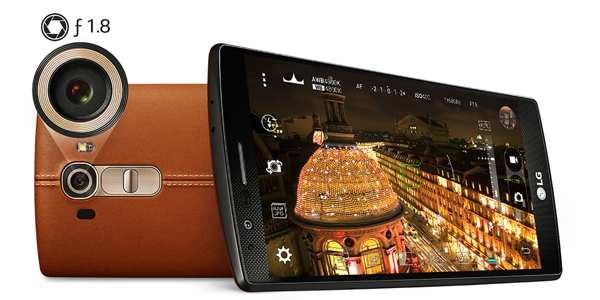LG G4 Announcement: What We Expect, What We Want
For the past couple of years, we've seen a pattern emerge when it comes to new Android smartphone releases. Each spring heralds the launch of the new mainstream flagship phone from the three biggest Android OEMs – HTC, LG and Samsung. This year, both HTC and Samsung have already started selling their flagships, the HTC One M9 and the Samsung Galaxy S 6, so LG is going to be the last one to arrive to the party. It is announcing its contender, the LG G4, later today.
Of the last round of flagships, LG's G3 was arguably the weakest. It had an overly ambitious screen spec that pushed its other hardware (SoC, battery) too far. If LG wants to be on top with the G4, it needs to up its game.
Design, Materials and Dimensions
Last year, both Samsung and LG were offering all-plastic devices. HTC's M8 was the only Android flagship constructed from metal, for which it was widely praised. The others were plastic.
If LG hopes to compete on the design and materials front with HTC and Samsung this spring, then the G4 must be made from more than just plastic. However, we don't necessarily subscribe to the notion that it has to be all metal, or metal and glass. That design decision usually precludes having a removable battery, a feature we think is essential. We do still hope, though, that LG has managed to incorporate some premium materials into the G4's design.
As for dimensions, in 2014 the G3 managed to squeeze a 5.5-inch screen into the body of a 5-inch device. The G3's screen-to-body ratio was 76 percent, which was substantially better than the S5's and One M8's. Also, because LG placed the volume and power buttons on the back (as it did on the G2), the G3 was still comfortable to use with one hand. If LG sticks with the same screen size and dimensions, then the G4 will continue to have the best screen-to-body ratio of this latest round of flagships.
It looks like LG is going to incorporate a premium material into the G4, but it's not the one we were necessarily hoping for. In leaked images from an LG Korea microsite that accidentally went live briefly, then later confirmed by the Korean teaser video below, it looks like the LG G4 will come with a leather back. That's real hand-stitched leather, not the faux-leather Samsung used on the Note 3. There will apparently be other leather colors to choose from, too, although we also expect a more traditional plastic-back option.
We want to at least see some metal in the G4's construction, so let's hope that at least the band surrounding the bezel is actually metal this time.
Get Tom's Hardware's best news and in-depth reviews, straight to your inbox.
Display
In 2014, the LG G3 was the first Android handset to ship with a 2560 x 1440 QHD IPS display. This was a noticeable achievement and resulted in the G3 having a much higher PPI (538) than its competition's 1920 x 1080 FHD displays (the S5 had 432 PPI, the One M8 441 PPI). Unfortunately, taking this route did have its drawbacks.
When we tested the G3, we found that the screen itself was "good but not great," underperforming in nearly every test -- brightness, contrast, color accuracy -- compared to the S5 and One M8. Another big drawback was that the pairing of a QHD display, the Snapdragon 801 SoC and 3,000 mAh that the G3 used was not ideal. The QHD screen was too power-hungry, despite optimizations such as dynamic display clocking that LG incorporated to address this. Further, the Adreno 330 GPU was not powerful enough to push the larger amount of pixels of the QHD screen. This lead to lag in the UI and poor performance when playing graphically-demanding games.
For 2015, LG faces even stiffer competition on the display front. The Galaxy S 6 has an even better display than the S5, and it's equipped with an SoC capable of powering it. If LG hopes to compete this year, it will have to equip the G4 with a substantially better screen than the G3.
Fortunately, we expect an "IPS Quantum Display" that promises a 25 percent brighter and 20 percent wider color range than the G3. We're not sure these improvements will make for a better-quality screen than the one found in the S 6, though. The one area LG will have a chance to improve on is power consumption. The S 6's QHD screen has a big impact on its battery life; if LG can equip the G4 with a more efficient display, it will have a big advantage.
We're perhaps reaching a bit here, but we can't help but wonder if that "Quantum Display" could incorporate LG's color-enhancing Quantum dot technology found in TV displays.
Camera
2014's mainstream flagships all took different approaches to producing the best smartphone images. HTC stuck with its low resolution 4 MP UltraPixel sensor and f/2.0 lens, which traded resolution for better low-light performance. Samsung decided to go in-house and produce its own 16 MP ISOCELL sensor for the S5 that featured extremely fast phase detection autofocus (PDAF) paired with an f/2.2 lens. LG strangely decided to stick with the same Sony 13 MP IMX135 sensor (paired with an f/2.4 lens) that the G2 used, and just upgraded its OIS (optical image stabilization) and added super-fast laser autofocus.
Our testing showed that while the G3's laser AF and OIS+ did help it produce good photos, its older sensor and slow lens impacted its performance.
For 2015, LG has to contend with an even better Samsung camera. The S 6 uses the same 16 MP Sony sensor with OIS as the Note 4 and pairs it with a very fast f/1.9 lens. The 20.7 MP camera on the HTC One M9 is very disappointing, so LG only has one competitor in this category. If LG wants to beat the S 6, it will need to stick with the good features of the G3, the AF system, and OIS+, and upgrade the G4's sensor and optics.
On the software side, while the G3's camera UI was good, and its auto mode worked well, the G3 did suffer from a lack of configurable options. With Android Lollipop allowing for more manual control of the camera, both Samsung and HTC have added modes that let you make manual adjustments to the camera, and LG will need to add the same.
The first of LG series of G4 teaser videos highlighted the f/1.8 lens, which looks to currently be the fastest lens of any smartphone. This should mean that the G4 will have excellent low-light performance, and be able to take close-up pictures with SLR-looking out-of-focus (bokeh) backgrounds without having to resort to software tricks to achieve this. LG then put out a second video about the G4's camera (see below), that also mentions two new features.
The first is more accurate color reproduction in photos, and the second is a new manual mode that gives you full control of all the camera settings. The only question remaining is what sensor will the G4 use? Information from the unconfirmed GFXBench results indicated it will be 16 MP, which suggests LG might be using the same Sony sensor as the Galaxy S 6.
SoC, Storage and Battery
Last year, all three flagships shared the same SoC, the Qualcomm Snapdragon 801. Although there were some minor differences, overall, if you don't take the impact of the G3's QHD screen into consideration, they all performed similarly. This year's flagship race is a totally different story, and if some of the rumors are correct, we may end up with three competitors all running different SoC's.
The Galaxy S 6 utilizes Samsung's Exynos 7420 that has a 4 x 2.1 GHz Cortex-A57 and 4 x 1.5 GHz Cortex-A53 CPUs in a big.LITTLE configuration. The 7420 has a Mali-T760 MP8 GPU.
HTC decided to stick with Qualcomm again, and the One M9 utilizes the latest and most power Snapdragon, the 810. The 810 is also a big.LITTLE chip, and it has a 4 x 2.0 GHz Cortex-A57 and 4 x 1.5 GHz Cortex-A53 cores with an Adreno 430 GPU. Unfortunately, this choice was probably not the best one, as the 810 runs very hot, meaning that when under load its speed has to be substantially throttled, which impacts its performance. (LG also used the same SoC in its G Flex 2 phone earlier this year, and it had the same performance issues.)
If the G4 is going to compete, then it needs to have an SoC that is as powerful as the ones found in the S 6 and One M9. However, it seems that LG is stuck between a rock and a hard place. The G4 certainly won't come with a Samsung SoC, and the 810 has so far proven to be a poor choice.
For storage, the big question is whether the G4 will have a microSD slot. In 2014, all the flagships offered this feature, but for 2015 Samsung decided to drop expandable storage, instead offering the (expensive) choice to get an S 6 with up to 128 GB of storage. HTC wisely kept a microSD slot on the M9, and we hope LG does the same.
The last important internal specification that we are concerned with is the battery. First, we do hope that LG continues to offer a removable battery like it did on the G3. Its competitors this year have decided to seal up the backs of their phones. We feel this is the wrong direction to take, even if rapid charging tech means you can juice up a phone much faster than before.
Battery capacity is also important. Although the G3 did have the biggest battery of the 2014 flagships, it also had a power-hungry display that nullified the benefits of the bigger cell. This year Samsung dropped the capacity of the S 6 to 2,550 mAh, and HTC has upped the M9's cell from 2,800 to 2,840 mAh. With these changes and more demanding SoCs, both of these phones have worse battery life than their predecessors. As long as LG can give the G4 the same or better battery life than the G3, we'll be happy.
Although LG has been happy to tease information about the G4's design, screen and camera, it hasn't disclosed anything about its internal specs. The only hint was a GFXBench benchmark result that is said to be from the G4. This result recorded a device using Qualcomm's new Snapdragon 808 SoC.
At first glance, this seems like a wise choice. The 808 is a hexacore chip with 2 x Cortex-A57 and 4 x Cortex-A53 CPUs. We don't know the clock speed, but the 808's CPUs should be able to provide close to comparable performance to the 7420 and the 810 under all but the most demanding loads.
However, there are a couple of aspects of the 808 that will worry us if the G4 does indeed use this chip. First, it doesn't support DDR4 memory, just DDR3; and its GPU, the Adreno 418, is likely to be slower than both the Adreno 430 in the 810 and the 420 in last year's Snapdragon 805. Still, seeing as we've never had a chance to test the 808, this is all speculation.
On the battery side, a leaked picture clearly shows that underneath the G4's removable back lurks a removable battery, which is great news. The writing on it seems to indicate that it will also be 3,000 mAh, which with hopefully better overall power-efficiency of the components chosen should give the G4 better battery life than its competitors.
Will LG Meet our Expectations?
Although there has already been quite a lot of information released and leaked about the G4, at the end of the day, we can't be sure of anything until LG officially announces it. If LG is able to meet our expectations, it could very well have the winner of this year's Android flagship race.
Stay tuned to Tom's Hardware for more news about the LG G4 as the day progresses.
Follow Alex Davies @alexbdavies. Follow us @tomshardware, on Facebook and on Google+.
-
fanchiuho I come from the G2, and damn it was a killer phone. It's about time that manufacturers take a step back on screen size and resolution dick contests; I would greatly appreciate an actual sub-flagship with a 5.0-5.2" FHD screen, SD slot and >3000mAh battery on lollipop.Reply
Looking at you, G4 beat. -
ern88 I don't need a phone with a 5 inch display that can do 4k. I need a phone that is all round good. A great 1080p. great camera. Storage for micro SD and a CPU/GPU That will power it. AND A BATTERY THAT WILL LAST FOR 3 DAYS. And removable. Not a phone with over powered CPU/GPU. sub standard camera and a stinking 4k display. while the phone lasts a half day on a charge!!!!Reply -
billybobser Not sure I understand the logic of these Octacore phones, the performance boost is dismal and the low power state is a joke. Doing this has gained them nothing.Reply
In summary, Xperia Z1 still going strong.
1080p, crazy camera, top processor, sd card, all week battery life and waterproof.
Nothing much has happened in mobile technology since this was released in 2013. -
jlocke13 i have the G3 brilliant phone.. replaceable battery and sd slot are a must for any phone theses days G4 is continuing this specReply -
kawininjazx What a terrible article. I have a G3 and I love it. The "weakest phone of the bunch"? It was the best phone at the time, compare it to the S5- Faster clocked CPU, 1GB more RAM, 16GB more storage, and higher screen resolution. My phone has always been very fast, no lag, it made me swtich from Samsung to LG. The rear buttons and the screen double tap are great.Reply -
drapacioli Metal is overrated, I'd rather have a durable plastic phone with good signal reception (as plastics better allow for cell signals to pass through) than a metal, dent and tarnishable phone. Plus let's not forget the inability (or rather unwillingness) for manufacturers to make a metal phone with removable battery and micro SD componentsReply -
ddt529 For me, battery life is a priority. I agree that the QHD display trend on phones seems to be a peen contest. LG G2 still beats both on battery life - 34 hours vs 19 hours.Reply
Just got the lollipop update for G2 and loving it. Until they can match the battery life of the G2 using QHD, I'll pass. Rather get a QHD tablet with a 8"+ screen that really takes advantage of the higher resolution. 1080p is more than enough for a phone. -
manon255 While most manufacturers rely on plastic, glass or metal, the Korean has chosen him to opt for genuine leather.Reply
A bold choice, which does not necessarily seduce all users, but which has at least the merit to stand out.




